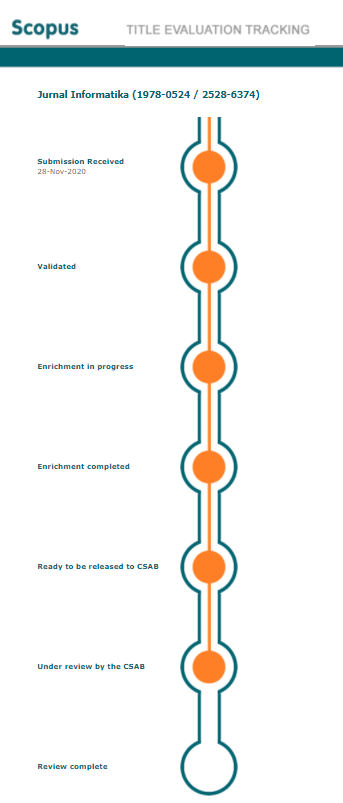Application to predict the new student’s score using time series algorithm
Abstract
Keywords
Full Text:
PDFReferences
B. Handaga and H. Amrullah, “Sistem Informasi Akademik Untuk Layanan Mahasiswa Ums Berbasis Mobile,†Emitor, vol. 16, no. 02, pp. 9–20, 2017.
Nia Komalasari, “Sistem Pendukung Keputusan Kelaikan Terbang (SPK2T),†J. Ind. Elektro dan Penerbangan 4, vol. 4, no. 1, pp. 1–11, 2014.
D. H. Kamagi and S. Hansun, “Implementasi Data Mining dengan Algoritma C4.5 untuk Memprediksi Tingkat Kelulusan Mahasiswa,†J. Ultim., vol. 6, no. 1, pp. 15–20, 2014, doi: 10.31937/ti.v6i1.327.
A. Rohman, “Model Algoritma K-nearest neighbor (K-NN) untuk prediksi kelulusan mahasiswa,†Neo Tek. J. Ilm. Teknol., vol. 1, no. 1, 2015.
H. Thamrin, “Perancangan Tools Berbasis Python Untuk Memantau Keaktifan Server,†Komuniti, vol. 2, 2017.
A. Khosravi, L. Machado, and R. O. Nunes, "Time-series prediction of wind speed using machine learning algorithms: A case study Osorio wind farm, Brazil," Appl. Energy, vol. 224, no. September, pp. 550–566, 2018, doi: 10.1016/j.apenergy.2018.05.043.
H. Zhang, S. Zhang, P. Wang, Y. Qin, and H. Wang, "Forecasting of particulate matter time series using wavelet analysis and wavelet-ARMA/ARIMA model in Taiyuan, China," J. Air Waste Manag. Assoc., vol. 67, no. 7, pp. 776–788, 2017, doi: 10.1080/10962247.2017.1292968.
N. A. Bakar and S. Rosbi, "Autoregressive Integrated Moving Average (ARIMA) Model for Forecasting Cryptocurrency Exchange Rate in High Volatility Environment: A New Insight of Bitcoin Transaction," Int. J. Adv. Eng. Res. Sci., vol. 4, no. 11, pp. 130–137, 2017, doi: 10.22161/ijaers.4.11.20.
H. Moeeni, H. Bonakdari, and I. Ebtehaj, "Integrated SARIMA with Neuro-Fuzzy Systems and Neural Networks for Monthly Inflow Prediction," Water Resour. Manag., vol. 31, no. 7, pp. 2141–2156, 2017, doi: 10.1007/s11269-017-1632-7.
N. S. Arunraj, D. Ahrens, and M. Fernandes, "Application of SARIMAX Model to Forecast Daily Sales in Food Retail Industry," Int. J. Oper. Res. Inf. Syst., vol. 7, no. 2, pp. 1–21, 2016, doi: 10.4018/ijoris.2016040101.
P. Sutthichaimethee and D. Ariyasajjakorn, "Forecasting energy consumption in short-term and long-term period by using ARIMAX Model in the construction and materials sector in Thailand," J. Ecol. Eng., vol. 18, no. 4, pp. 52–59, 2017, doi: 10.12911/22998993/74396.
M. F. Ani, S. R. Kamat, and M. Fukumi, "Development of Decision Support System via Ergonomics Approach for Driving Fatigue Detection," vol. 1, no. 1, pp. 60–72, 2020.
H. Khan and P. Pohwani, "Testing Phillips Curve in Pakistan," J. Public Value Adm. Insight, vol. 3, no. 3, pp. 145–152, 2020.
X. Ying, "An Overview of Overfitting and its Solutions," J. Phys. Conf. Ser., vol. 1168, no. 2, 2019, doi: 10.1088/1742-6596/1168/2/022022.
F. Rahmi Ras, H. Nelly Astuti, and B. Efori, “Perancangan Sistem Pakar Diagnosa Penyakit Asidosis Tubulus Renalis Menggunakan Metode Certainty Factor Dengan Penelusuran Forward Chaining,†Media Inform. Budidarma, vol. 1, no. 1, pp. 13–16, 2017.
DOI: http://dx.doi.org/10.26555/jifo.v14i3.a17639
Refbacks
- There are currently no refbacks.
Copyright (c) 2020 Sinar Nadhif Ilyasa, Husni Thamrin

This work is licensed under a Creative Commons Attribution-ShareAlike 4.0 International License.
____________________________________
JURNAL INFORMATIKA
ISSN :Â 1978-0524 (print) | 2528-6374 (online)

This work is licensed under a Creative Commons Attribution-ShareAlike 4.0 International License.






